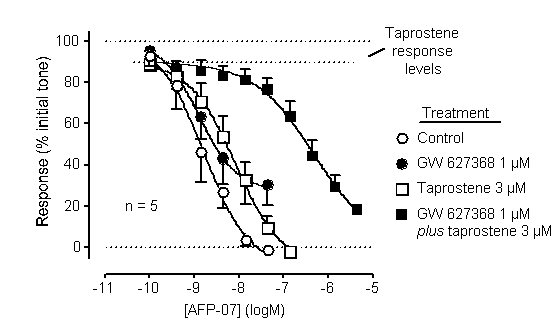| pA2 online © Copyright 2004 The British Pharmacological Society |
085P
University of Bath Summer Meeting July 2004 |
|
Assessing the potency of prostacyclin analogues at EP4 prostanoid receptors using GW 627368 and taprostene Robert L. Jones & Kam-ming Chan, Department of Pharmacology, The Chinese University of Hong Kong, Hong Kong SAR, China |
|
We have previously reported that relaxations of pig and rabbit saphenous veins induced by the prostacyclin analogues AFP-07 and cicaprost are due to activation of both EP4 and IP prostanoid receptors (Jones & Chan, 2001). The study was limited, however, by the low affinity of AH 23848 (pA2 = 5.4), the only EP4 antagonist available at that time. We now report new experiments with GW 627368, a much more potent EP4 blocker (pA2 = 9.2 for pig saphenous vein; Wilson et al., 2003), in combination with taprostene, which behaves as an IP partial agonist (Jones & Chan, 2001).
Tension in saphenous vein rings from male Landrace pigs (10 - 14 kg) and New Zealand White rabbits (3 - 4 kg) was recorded with wire-myographs. Preparations were bathed in Krebs-Henseleit solution aerated with 95% O2 / 5% CO2 at 37 oC, containing indomethacin (1 µM) and the TP antagonist GR 32191 (1 µM). Tone was induced with phenylephrine (60% of maximum for pig; 60 and 85% of maximum for rabbit) followed by cumulative addition of relaxant agent. Matched preparations were treated as follows: vehicle (control), 1 µM GW 627368, 3 µM taprostene, and 1 µM GW 627368 plus 3 µM taprostene.
Relaxations of pig and rabbit (low tone) preparations induced by PGE2 (pIC50 = 9.37 ± 0.16, n = 3 and 9.64 ± 0.18, n = 5, respectively) were blocked by GW 627368 (dose-ratio = 315 ± 75 and 19 ± 3 respectively), confirming the presence of EP4 receptors. On pig saphenous vein (Figure 1), GW 627368 reduced the maximum response of AFP-07 with little change in IC50. However, in the presence of taprostene, GW 627368 caused a large right-shift of the AFP-07 log concentration-response curve. A similar picture was obtained for cicaprost (control pIC50 = 7.70 ± 0.02, n = 4; dose-ratio in the presence of taprostene = 141 ± 51), whereas relaxation induced by the selective EP2 agonist ONO-AE1-259 (Cao et al., 2001) was unaffected by GW 627368 both with and without taprostene (control pIC50 = 7.06 ± 0.10, n = 5; dose-ratio <2.0). On rabbit saphenous vein under low tone, relaxations to cicaprost, AFP-07 and ONO-AE1-259 (control pIC50 = 7.91 ± 0.11, 9.20 ± 0.13 and 8.95 ± 0.12 respectively, all n = 5) were not blocked by GW 627368 alone. Under high tone, IC50 values for the 3 relaxants were ~10-fold larger, and antagonism by GW 627368 both with and without taprostene was minimal (dose-ratio ![]() 2.3).
2.3).
Figure 1. Effect of GW 627368 and taprostene on relaxation of pig saphenous vein induced by AFP-07.

In conclusion, the GW 627368 / taprostene combination shows that AFP-07 and cicaprost are moderately potent agonists on pig EP4 receptors, while having much lower potency on rabbit EP4 receptors. The rabbit saphenous vein results differ from those of our previous study, in which 30 µM AH 23848 produced significant right-shifts of the AFP-07 and cicaprost log concentration-response curves (low tone protocol). We propose that the higher selectivity of GW 627368 accounts for this difference. In relation to species differences, cicaprost has much higher affinity for human EP4 receptors (Ki = 44 nM; Abramovitz et al., 2001) compared to mouse EP4 receptors (Ki > 10,000 nM; Kiriyama et al., 1997).
Abramovitz, M et al. (2001). Biochim Biophys Acta,1483, 285-293
Cao, J et al. (2002). Eur J Pharmacol, 442, 115-123
Jones, RL & Chan, KM (2001). Br J Pharmacol, 134, 313-324
Kiriyama, M et al. (1997). Br J Pharmacol, 122, 217-224
Wilson, R et al. (2003). Br J Pharmacol, 138, 84P